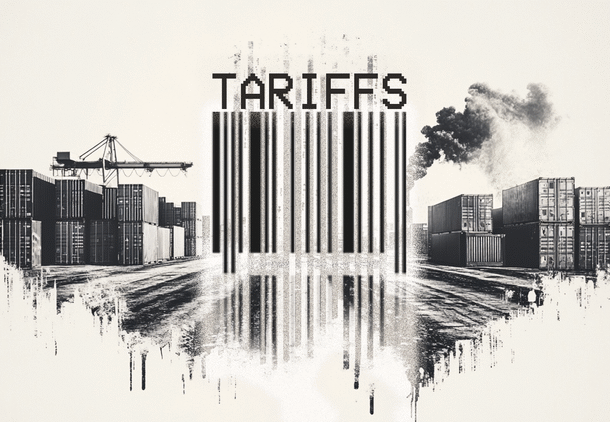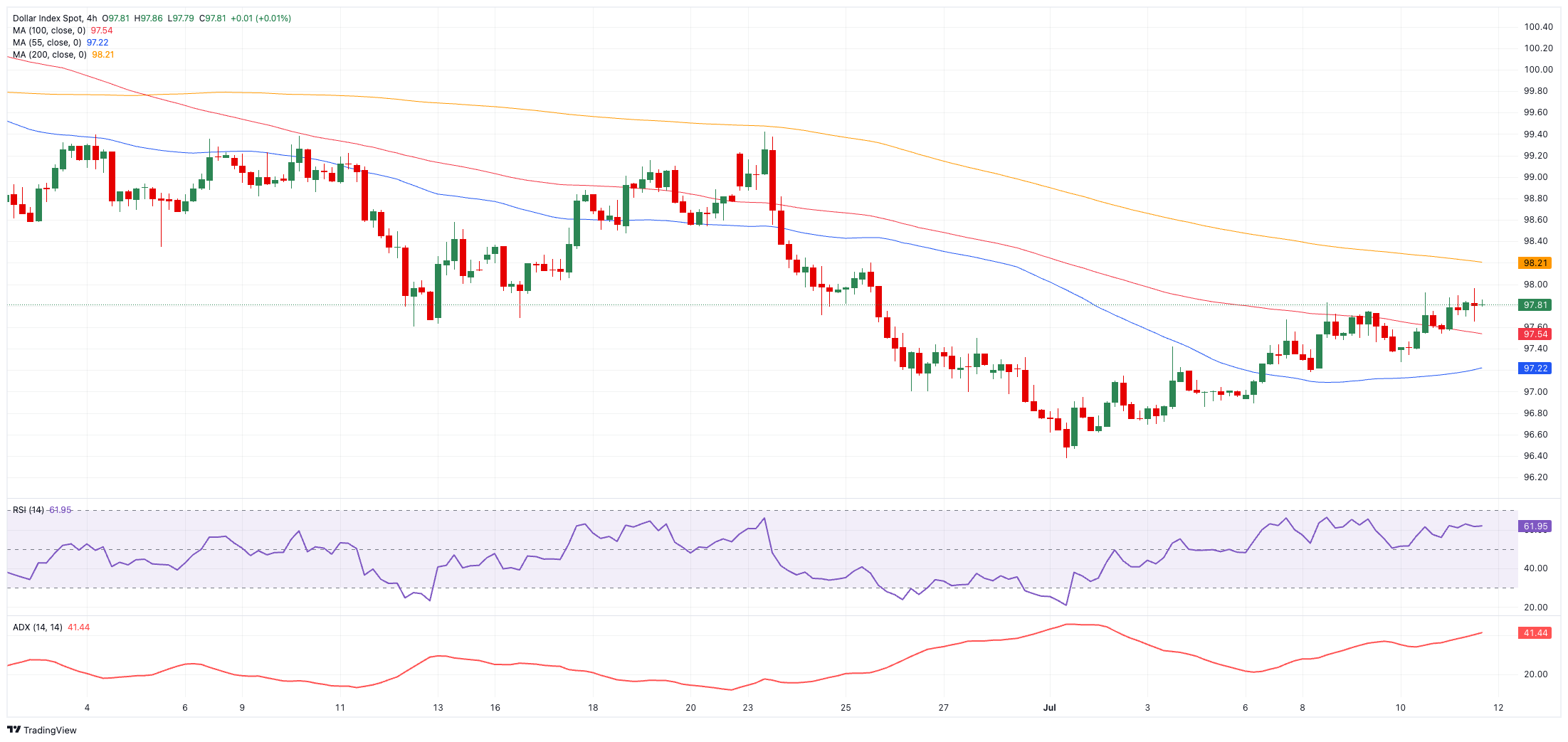
- The US Dollar Index reversed two weekly declines in a row.
- Markets’ attention shifted back to the trade front amid renewed tariffs.
- The Fed will likely stay on the sidelines in July.
The week that was
Came July, the US Dollar (USD) saw a resurgence of buying pressure, helping the US Dollar Index (DXY) stage a meaningful rebound from multi-year troughs in the 96.40-96.30 band to levels near the key 98.00 barrier.
Examining the monthly chart reveals a temporary pause in the steep retracement that has been in place since February, but the Greenback remains vulnerable.
Geopolitical tensions have somewhat eased, allowing the trade narrative to once again dominate global markets, driving both sentiment and price action almost exclusively.
Additionally, US yields underpinned the US Dollar’s recovery, maintaining their business in the upper end of the range.
Another factor driving the renewed upbeat tone in the Greenback came from the US calendar, with solid results from key fundamentals that reinforced the view of a resilient economy.
Tariff troubles return
US President Donald Trump signalled a harder stance on trade, reaffirming that a 25% tariff on goods from Japan and South Korea will take effect on August 1, though he left the door open for extensions if countries present alternative proposals. On Monday, Trump publicly shared letters outlining the tariffs via his social media platform.
Trump escalated the situation by announcing a new 50% tariff on imported copper, which will also start on August 1. The move aims to boost domestic production of a material he called critical for the US defence, electronics, and automobile industries.
“This is about national strength and economic independence,” Trump said, echoing past justifications for similar measures in steel and aluminium. Economists, however, warn that such targeted tariffs could feed into broader inflationary pressures and weigh on consumer costs.
Additional trade actions may be forthcoming. Trump told reporters on Tuesday that new tariffs on semiconductors are in the works, along with a separate announcement on pharmaceuticals, though he declined to offer specifics.
The administration also appears to be preparing to involve the European Union (EU). Trump suggested that he could send a formal letter detailing tariff proposals to Brussels by Friday, which could disrupt the ongoing US-EU trade negotiations.
An examination of the topic shows that even a decrease in tariffs might hurt the economy in the long run.
Even while early price increases may be less likely, long-term trade barriers are expected to keep prices high in many sectors, limit consumer spending, and slow down overall economic growth. If these risks come true, the Federal Reserve (Fed) may have to change its present ’wait-and-see’ approach.
Although the talks are still ongoing, evidence indicates that the White House desires a weaker US Dollar. How can we expect the Trump administration to fix the trade deficit, which is at an all-time high, in a timely manner? A plan to bring industries back to the US is in the works, but it will take time and money.
Shrinking bets on a July rate cut
As expected, the Federal Open Market Committee (FOMC) kept its policy rate unchanged at its meeting on June 17 and 18. The announcement, the press conference, and the updated dot plot, on the other hand, got a lot of attention.
When taken together, the signals seemed less aggressive than anticipated, with authorities estimating a potential 50 basis point reduction by the end of the year. The Committee is operating in a climate marked by poor growth projections and a high unemployment rate, offset by a moderately better inflation outlook.
Fed Chair Jerome Powell’s subsequent press conference did not clarify expectations for the two expected interest rate cuts. He maintained a patient tone, stating that the Fed expects tariff-related pricing pressure to manifest in the coming months.
During his semiannual speech, Powell reminded Congress that rising import taxes would contribute to higher inflation this summer, a vital time for measuring the impact of rate reduction. Powell said that President Trump’s tariffs might make things more expensive, which highlights the importance of the Fed maintaining a cautious balance between trade tensions and other global issues.
Only a few officials, according to the Federal Reserve’s policy meeting Minutes, believe interest rates could be cut as early as July. Despite some agreement that easing might be necessary later in the year, most remain concerned about inflationary risks, especially from President Trump’s tariff-driven trade approach.
Despite Trump’s calls for immediate rate cuts and his demand for Jerome Powell’s resignation as Fed Chair, the Minutes show limited support among 19 policymakers for reducing borrowing costs in the near term. The Fed’s dot plot indicates a median expectation of two quarter-point cuts by the end of 2025, while market participants predict a first cut in September and a second in December.
The mood inside the FOMC
This week, Fed rate setters showed they were open to lowering rates and preferred lower rates to help growth or keep things stable.
Federal Reserve Governor Christopher Waller said that the Fed could lower interest rates this month, as money is really scarce right now. Waller makes decisions based on economic research, not political factors.
Mary Daly, the President of the Federal Reserve Bank of San Francisco, also wants rates to go down, although she doesn’t specify when. Daly thinks it’s time to look at whether lower interest rates are still needed to keep the economy stable. She thinks there will be two rate cuts, but she also says there is still a lot of uncertainty.
What’s next for the US Dollar?
The release of the US Inflation Rate for the month of June will take centre stage next week, seconded in relevance by Retail Sales and the flash print of the Consumer Sentiment tracked by the University of Michigan.
In addition, Fed officials are expected to voice their opinions ahead of the blackout period prior to the July 30 meeting.
What about techs?
Once the multi-year low of 96.37 (July 1) is overcome, the index might reach the February 2022 floor of 95.13 (February 4), which is slightly above the 2022 base of 94.62 (January 14).
On the upside, there is an interim hurdle at the 55-day SMA at 98.93, prior to the June ceiling of 99.42 (June 23). The weekly high of 100.54 (May 29) lies north of here, and it surpasses the May high of 101.97 (May 12).
In the meantime, the index is set to continue its downward trend as long as it remains below the 200-day and 200-week Simple Moving Averages (SMAs), which are now at 103.64 and 103.02, respectively.
Furthermore, momentum indicators continue to have a slightly bearish skew. The Relative Strength Index (RSI) has rebounded to nearly 48, while the Average Directional Index (ADX) is declining to 13, suggesting a lack of trend strength.
US Dollar Index (DXY) daily chart

All in all
The US Dollar’s retracement is far from complete.
Despite sporadic flashes of strength, the Greenback is poised to test lower lows amid persistent uncertainty from the White House over trade policy and rising budgetary worries, particularly after Trump’s “Big and Beautiful Bill” became law.
The Federal Reserve may postpone the continuation of its easing cycle, but its data-driven approach may swing between good and negative results, with periodic support for the US Dollar seeming fleeting.
There are no catalysts, at least in the near term, to cause the US Dollar to reverse course and begin a convincing rebound, whether locally or worldwide.
The only way to address the significant US trade deficit is to weaken the currency. President Trump, like all politicians, fully understands this, so expect the US Dollar to suffer as a result.
US-China Trade War FAQs
Generally speaking, a trade war is an economic conflict between two or more countries due to extreme protectionism on one end. It implies the creation of trade barriers, such as tariffs, which result in counter-barriers, escalating import costs, and hence the cost of living.
An economic conflict between the United States (US) and China began early in 2018, when President Donald Trump set trade barriers on China, claiming unfair commercial practices and intellectual property theft from the Asian giant. China took retaliatory action, imposing tariffs on multiple US goods, such as automobiles and soybeans. Tensions escalated until the two countries signed the US-China Phase One trade deal in January 2020. The agreement required structural reforms and other changes to China’s economic and trade regime and pretended to restore stability and trust between the two nations. However, the Coronavirus pandemic took the focus out of the conflict. Yet, it is worth mentioning that President Joe Biden, who took office after Trump, kept tariffs in place and even added some additional levies.
The return of Donald Trump to the White House as the 47th US President has sparked a fresh wave of tensions between the two countries. During the 2024 election campaign, Trump pledged to impose 60% tariffs on China once he returned to office, which he did on January 20, 2025. With Trump back, the US-China trade war is meant to resume where it was left, with tit-for-tat policies affecting the global economic landscape amid disruptions in global supply chains, resulting in a reduction in spending, particularly investment, and directly feeding into the Consumer Price Index inflation.
Information on these pages contains forward-looking statements that involve risks and uncertainties. Markets and instruments profiled on this page are for informational purposes only and should not in any way come across as a recommendation to buy or sell in these assets. You should do your own thorough research before making any investment decisions. FXStreet does not in any way guarantee that this information is free from mistakes, errors, or material misstatements. It also does not guarantee that this information is of a timely nature. Investing in Open Markets involves a great deal of risk, including the loss of all or a portion of your investment, as well as emotional distress. All risks, losses and costs associated with investing, including total loss of principal, are your responsibility. The views and opinions expressed in this article are those of the authors and do not necessarily reflect the official policy or position of FXStreet nor its advertisers. The author will not be held responsible for information that is found at the end of links posted on this page.
If not otherwise explicitly mentioned in the body of the article, at the time of writing, the author has no position in any stock mentioned in this article and no business relationship with any company mentioned. The author has not received compensation for writing this article, other than from FXStreet.
FXStreet and the author do not provide personalized recommendations. The author makes no representations as to the accuracy, completeness, or suitability of this information. FXStreet and the author will not be liable for any errors, omissions or any losses, injuries or damages arising from this information and its display or use. Errors and omissions excepted.
The author and FXStreet are not registered investment advisors and nothing in this article is intended to be investment advice.







